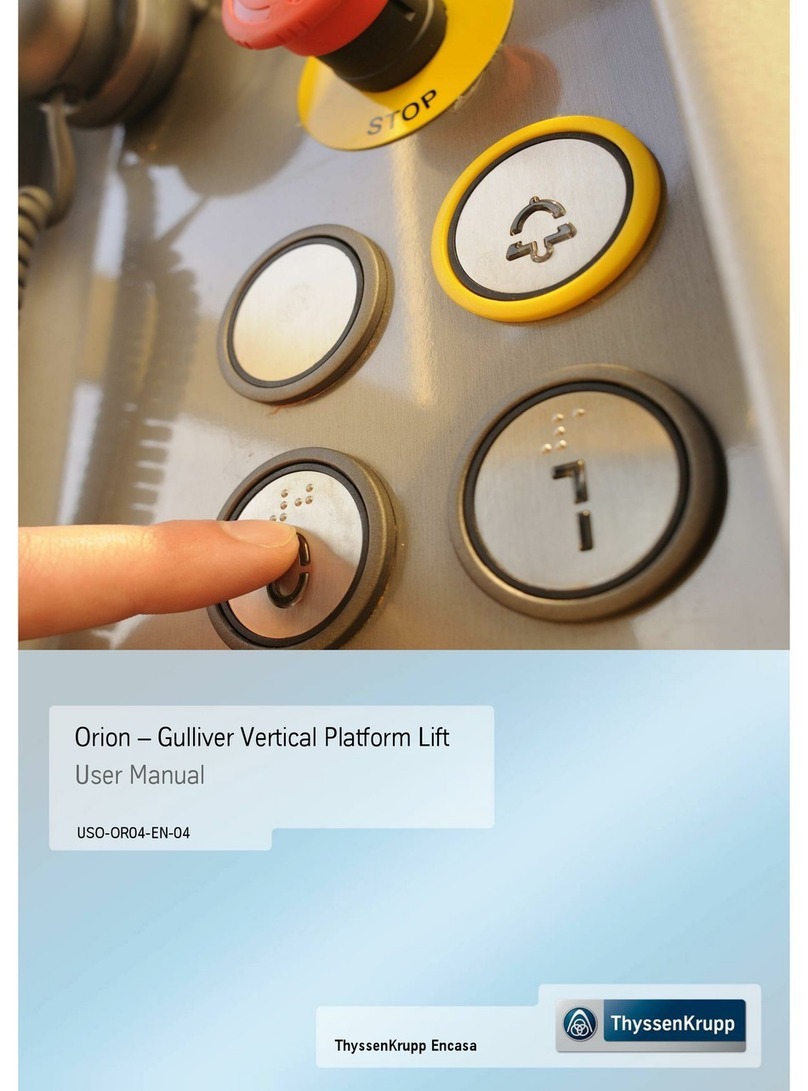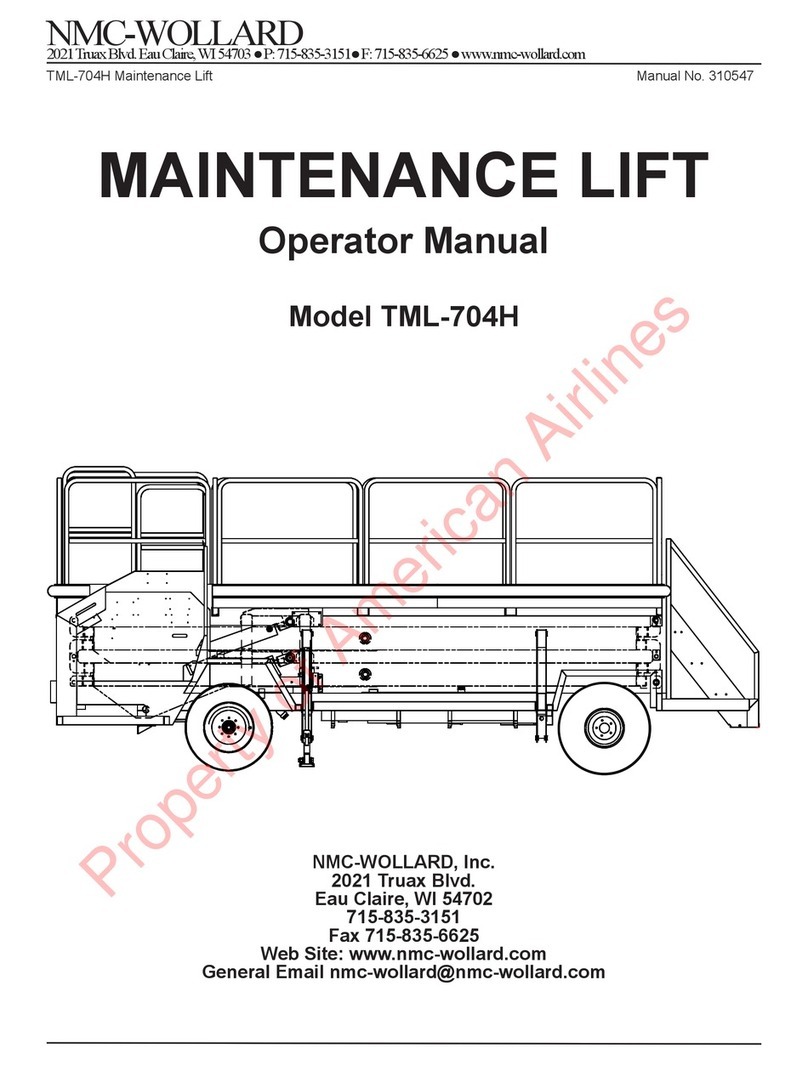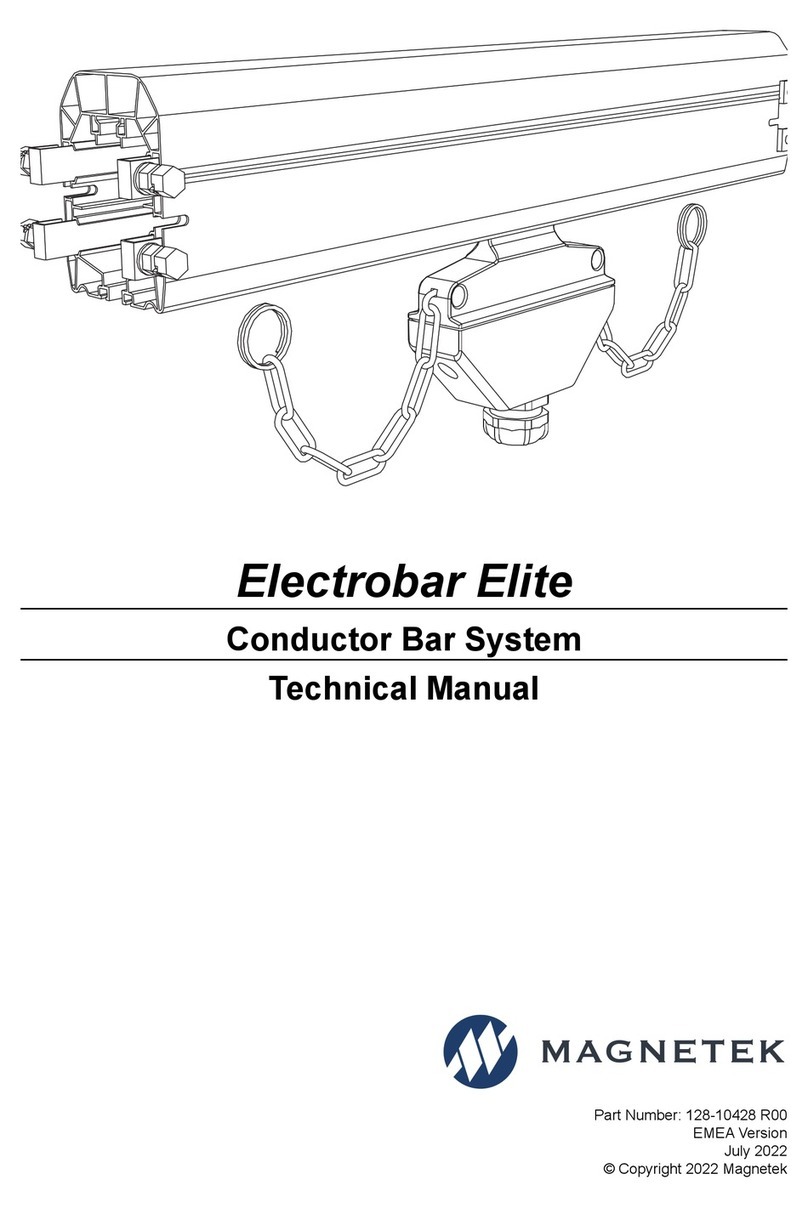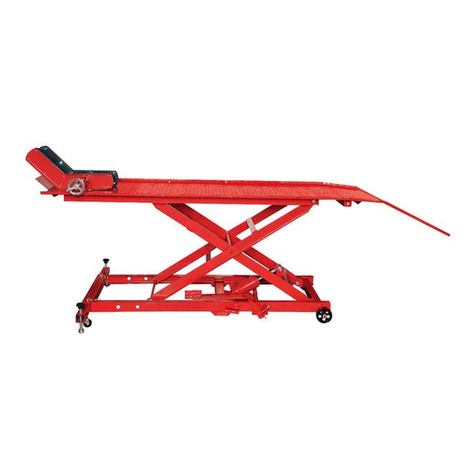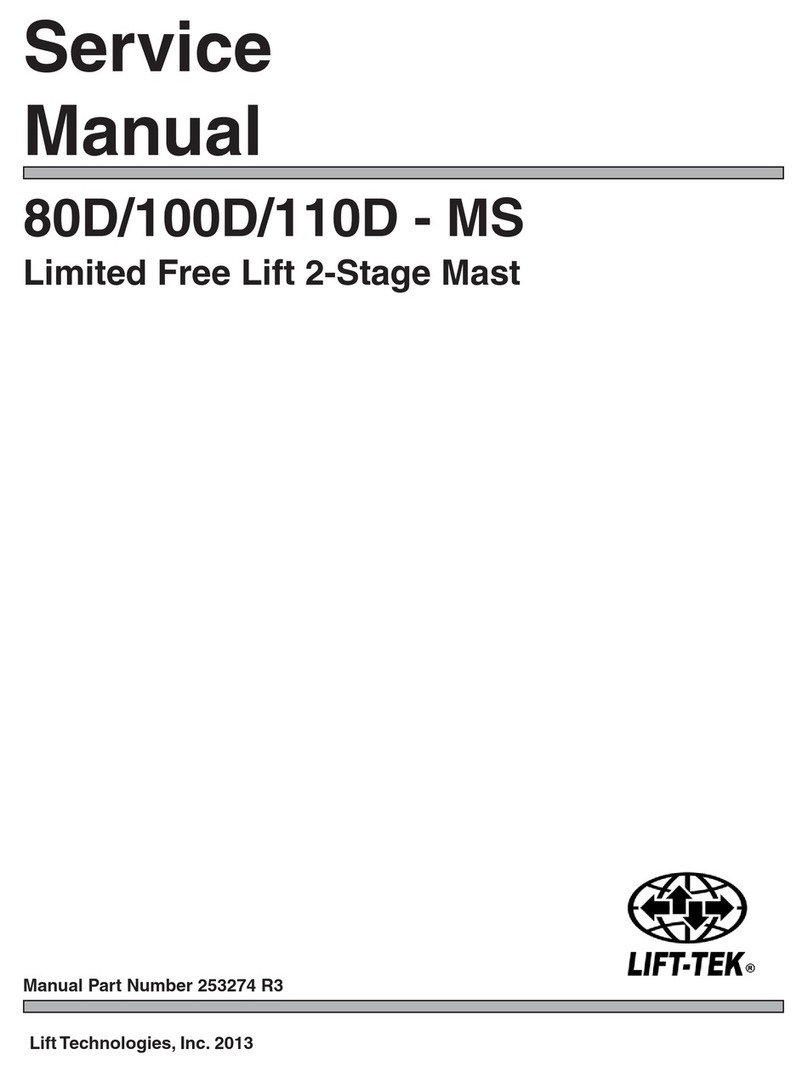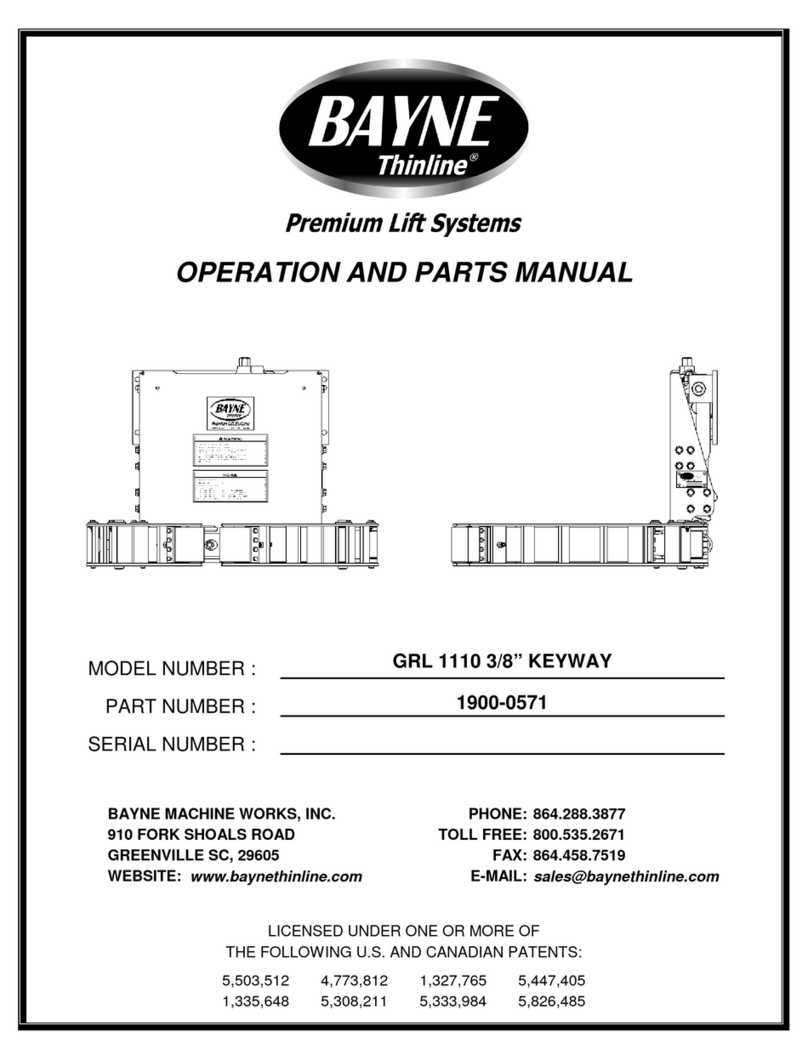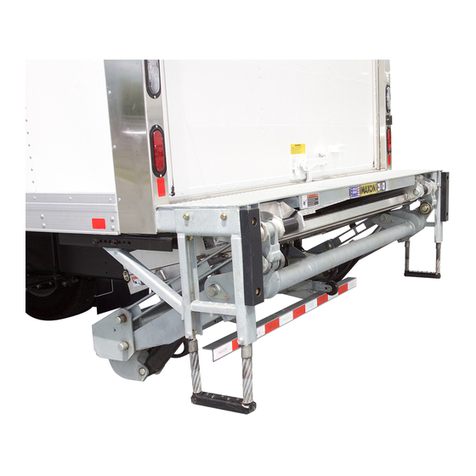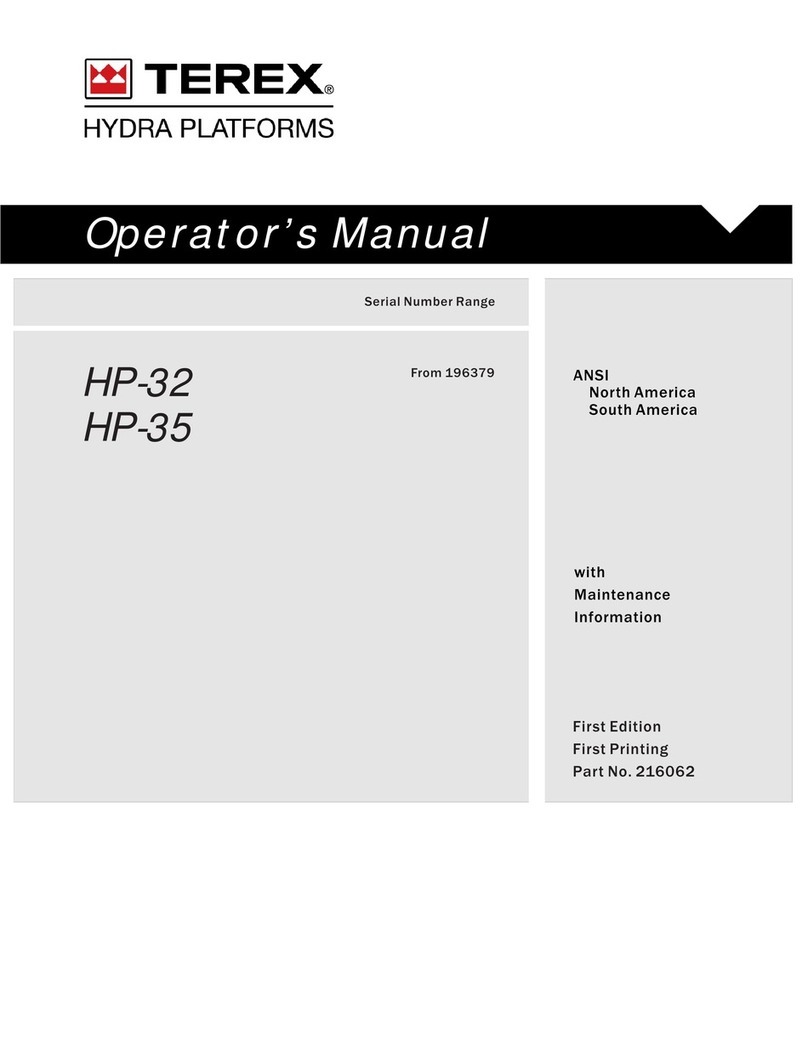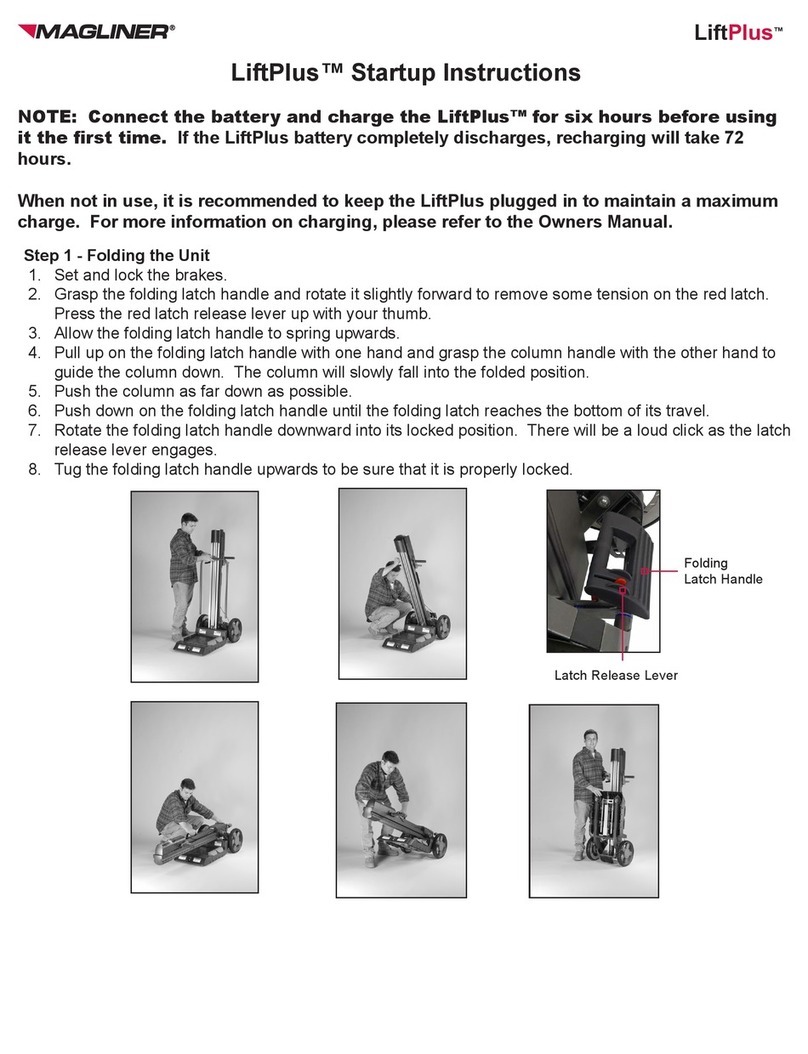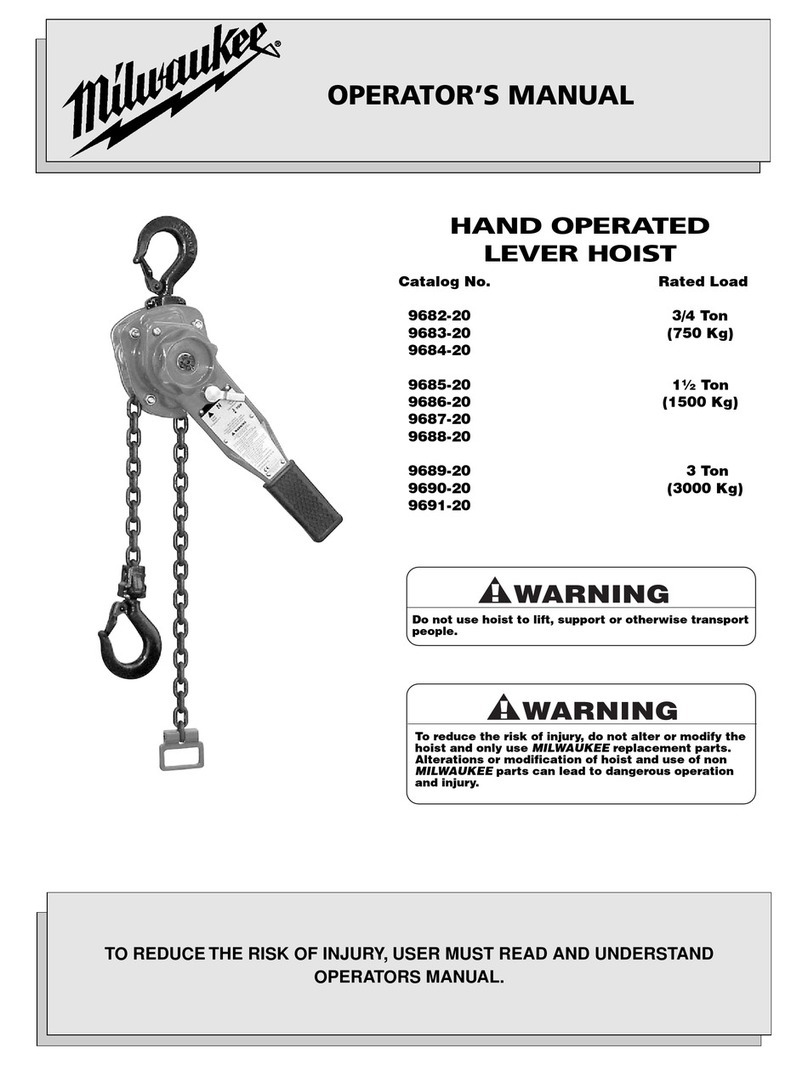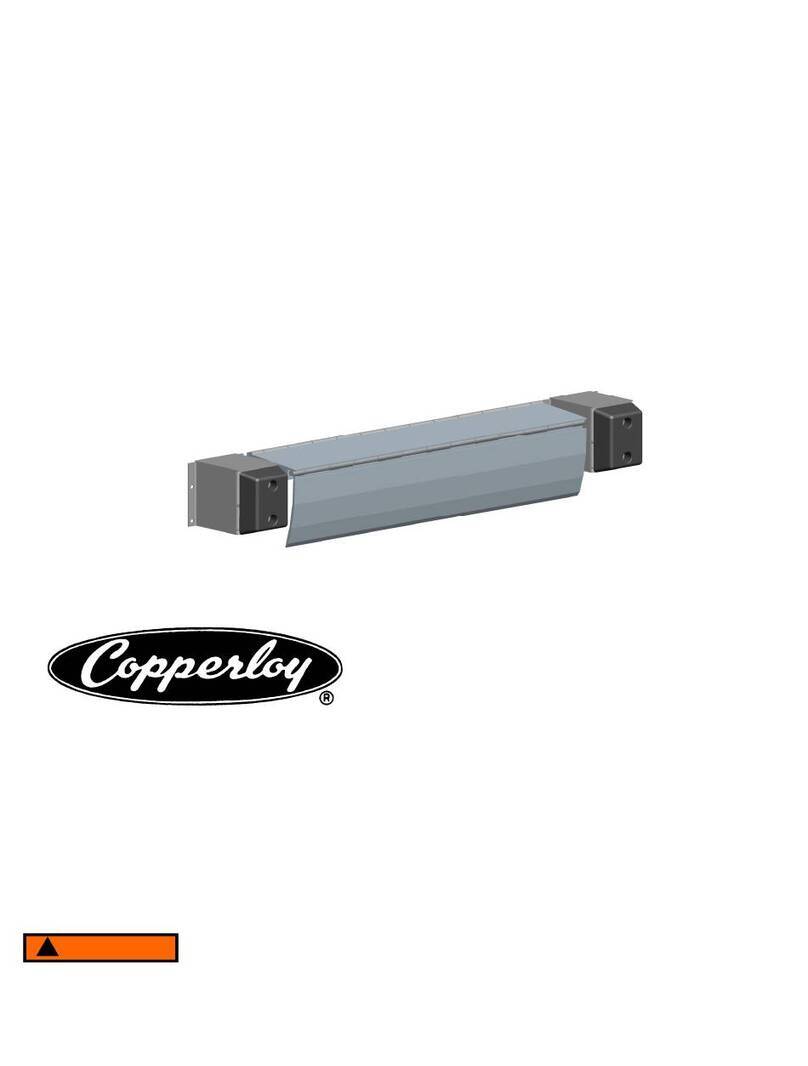AMF-BRUNS K70 User manual

Operating Instructions
BACK-IN-BOX LIFT K70 K90 / K90 ACTIVE
www.amf-bruns.de


Foreword
Back-in-Box-Lift K70 / K90 / K90 ACTIVE Page 3 of 100
Foreword
Dear Reader,
these Operating Instructions provide all information neces-
sary to safely operate the Back-in-Box-Lifts K70, K90 and
K90 ACTIVE.
The Back-in-Box-Lifts are designed and constructed in ac-
cordance with state of the art technology and recognised
safety standards. Persons and materials can however be
endangered, as not all danger areas can be eliminated if
the functional capability is to be maintained. Accidents
caused by these dangers can however be prevented by
strictly observing these Operating Instructions. Over and
above this, the operational efficiency of your Back-in-Box-
Lift can be used to the full and unnecessary faults can be
prevented.
After reading these Operating Instructions for the first time,
keep them in a safe place for future reference over the en-
tire lifetime of the Back-in-Box-Lift. Chapter 10 of these
Operating Instructions contains an Inspection Log that is
required by the technical expert for his / her annual inspec-
tion of the Back-in-Box-Lift.
If you sell the Back-in-Box-Lift, hand these Operating In-
structions over to the new owner.
All details, figures and dimensions contained in these Op-
erating Instructions are non-binding. No claims in any form
can be derived from these.
This document must not be reproduced or duplicated, in
full or in part, without the prior, written permission of the
manufacturer.
The Back-in-Box-Lift must never be converted or modified
in any way, without seeking the prior, written permission of
the manufacturer. The manufacturer will not be held re-
sponsible in any way whatsoever if conversions or modifi-
cations are carried out without authorisation.
Use only original spare parts or spare parts which have
been approved of by the manufacturer. If spare parts other
than these are used, this can have a negative effect on the
specified characteristics, the functionality and safety of the
Back-in-Box-Lift. Using non-original or unauthorised spare
parts will render the guarantee null and void.
Contact our customer services department to order spare
parts or accessories (see Chapter 13, page 98).

Foreword
Page 4 of 100 Back-in-Box-Lift K70 / K90 / K90 ACTIVE
Explanation of symbols and signs
To improve understanding, the following conventions
should be met for these Operating Instructions:
1.
The following conventions are used to highlight important
information:
DANGER!
• warns of a situation of immediate danger, which will lead
to severe or fatal injuries, if not avoided.
WARNING!
• warns of a potentially dangerous situation, which will
lead to severe or fatal injuries, if not avoided.
CAUTION!
• warns of a potentially dangerous situation, which will
lead to slight or minor injuries or material damage if not
avoided.
ATTENTION!
...warns of a potentially dangerous situation, which can
cause material damage, if not avoided.
...contains general notes and useful information.
...gives a reference to important information in other sec-
tions and documents.
2.
Some texts serve a particular purpose. These are identified
as follows:
• Lists.
ð Instructional text, e.g. a sequence of activities.

Contents
Back-in-Box-Lift K70 / K90 / K90 ACTIVE Page 5 of 100
Contents
Foreword .............................................................. 3
Contents ............................................................... 5
1 Safety............................................................... 8
1.1 Proper Use ............................................................ 8
1.2 Improper Use ........................................................ 9
1.3 User Requirements...............................................10
1.4 Product Monitoring............................................... 11
1.5 Danger Zone ........................................................ 11
1.6 Safety Devices...................................................... 12
1.6.1 Roll-off guard ..............................................12
1.6.2 Signalling systems .......................................12
1.6.3 Door contact switch ....................................12
1.7 Safety and Accident Prevention Regulations.........13
1.8 Disposal................................................................14
2 Description...................................................... 15
2.1 Layout and Function .............................................15
2.1.1 Platform ...................................................... 17
2.1.2 Mechanics and hydraulics with carrier
arms........................................................... 20
2.1.3 Cassette .....................................................21
2.2 Rating plate ......................................................... 22
2.3 Operating Controls and Indicators....................... 23
2.3.1 Cable-connected remote control ............... 23
2.3.2 Bluetooth remote control (optional extra).... 24
2.3.3 Remote control per Smartphone APP ........ 26
2.4 Technical Data..................................................... 27
3 Transportation ............................................... 28
4 Installation / Commissioning........................... 29
5 Operation ....................................................... 30
5.1 Safety Regulations for Operation ......................... 30
5.2 Embarkation Procedure....................................... 33
5.3 Disembarkation Procedure .................................. 38
5.4 Refuelling the Vehicle (K70 and K90 only).............41

Contents
Page 6 of 100 Back-in-Box-Lift K70 / K90 / K90 ACTIVE
6 Emergency Mode ........................................... 42
6.1 Emergency Operation K70 / K90 ......................... 42
6.1.1 Extending the platform from the cassette .. 42
6.1.2 Raising the platform ................................... 44
6.1.3 Lowering the platform ................................ 45
6.1.4 Retracting the platform into the cassette ... 46
6.2 Emergency Operation K90 ACTIVE...................... 48
6.2.1 Raising the platform ................................... 48
6.2.2 Lowering the platform ................................ 49
6.2.3 Retracting the platform into the cassette ... 50
7 Maintenance and Repair ................................ 53
7.1 Safety Regulations for Maintenance and Repair .. 53
7.2 Routine Maintenance Work ................................. 54
7.2.1 Maintenance schedule ............................... 54
7.2.2 Maintenance record................................... 54
7.3 Functional Test of the Safety Devices .................. 55
7.3.1 Roll-off guard ............................................. 55
7.3.2 Signalling system........................................ 55
7.3.3 Door contact switch ................................... 55
7.4 Inspection of the Hydraulic Hoses. ...................... 56
7.5 Yearly Inspection ................................................. 56
7.6 Maintenance and Repair Record ......................... 57
8 De-Commissioning and Conservation ............ 58
9 Faults and Troubleshooting............................ 58
9.1 Adjustments if the Platform Jerks When Being
Retracted Into the Cassette (K70 / K90).............. 62
9.1.1 Adjusting the switching point for the
retract position (K70 / K90) ........................ 64
9.1.2 Adjusting the rollers (K70 / K90)................. 67
9.2 Adjusting the Switching Point for the Retract
Position (K90 ACTIVE) ......................................... 68
9.3 Charging the Bluetooth Remote Control Battery . 70
9.4 Teaching the Bluetooth remote control in............. 71
9.5 Installing the remote control App and
teaching it in ........................................................ 72

Contents
Back-in-Box-Lift K70 / K90 / K90 ACTIVE Page 7 of 100
10 Inspection Log ............................................... 73
10.1 Inspection Log Master Data Sheet ...................... 74
10.2Inspection List ..................................................... 75
10.3Inspection Results ............................................... 76
11 Electrical Circuit Diagrams............................. 87
11.1 Electrical Circuit Diagram, Bluetooth Remote
Control K70 (optional).......................................... 87
11.2 Electrical Circuit Diagram, Bluetooth Remote
Control K90 /K90A (optional)............................... 87
11.3 Electrical Circuit Diagram K70.............................. 88
11.4 Electrical Circuit Diagram K90.............................. 90
11.5 Electrical Circuit Diagram K90 ACTIVE................. 93
12 Hydraulic Line Diagrams ................................ 95
12.1 Hydraulic Circuit Diagram K70 ............................. 95
12.2Hydraulic Circuit Diagram K90 ............................. 96
12.3Hydraulic Circuit Diagram K90 ACTIVE ................ 97
13 Customer Service .......................................... 98
14 Declaration of Conformity .............................. 99

Safety
Page 8 of 100 Back-in-Box-Lift K70 / K90 / K90 ACTIVE
1 Safety
CAUTION!
There are a number of risks of suffering personal injury and
material damage involved in the operation and mainte-
nance of the Back-in-Box-Lift.
Therefore:
• It is imperative, that these Operating Instructions are
read thoroughly before operating your Back-in-Box-Lift.
Always observe the notes and information contained
therein, in particular the safety instructions.
• If these Operating Instructions or parts thereof are lost
or become illegible, please request a new copy from the
manufacturer.
Prerequisite to the safe handling and trouble-free opera-
tion of the Back-in-Box-Lift is a thorough knowledge of the
applicable safety information and the safety regulations.
It is therefore imperative that this Chapter is read thor-
oughly before operating the Back-in-Box-Lift and that the
instructions and warnings herein are strictly observed. The
safety information and warnings, given at the appropriate
places in the following Chapters, must also be strictly ob-
served. The manufacturer will not be held responsible if
safety information and warnings are not observed.
In addition to the information given in these Operating In-
structions, local legislative regulations must be taken into
consideration, in particular those regarding safety and ac-
cident prevention.
1.1 Proper Use
The Back-in-Box-Lift must only be used for lifting and low-
ering disabled persons seated in wheelchairs or empty
wheelchairs. By using the Back-in-Box-Lift, persons can
be embarked into or disembarked from the vehicle to
which it is fitted.
Proper use also includes strictly adhering to the infor-
mation given in these Operating Instructions.

Safety
Back-in-Box-Lift K70 / K90 / K90 ACTIVE Page 9 of 100
WARNING!
If the Back-in-Box-Lift is used for any other purpose than
that described above, this may result in dangerous situa-
tions for persons or to material damage being caused.
Therefore:
• Only use the Back-in-Box-Lift for the purpose for which
it was intended.
• Always adhere to information given in these Operating
Instructions.
• Do not use the Back-in-Box-Lift for any other purposes,
particularly those given in Section 1.2. These are
deemed to be improper use.
1.2 Improper Use
Any use other than that described in Section 1.1 is deemed
to be improper use.
The Back-in-Box-Lift is deemed to be improperly used if
for example:
• it is used for lifting and lowering goods,
• it is used for lifting and lowering persons who are not
seated in a wheelchair,
• it is operated by persons who do not fulfil the necessary
requirements (see Section 1.3).

Safety
Page 10 of 100 Back-in-Box-Lift K70 / K90 / K90 ACTIVE
1.3 User Requirements
The Back-in-Box-Lift must only be handled by persons
who:
• have been instructed in how to operate the Back-in-
Box-Lift,
• have read and understood these Operating Instructions
and
• have the technical knowledge to operate the wheel-
chair's brakes and switch the motors of electrically driv-
en wheelchairs ON and OFF.
Over and above this, the following applies if the Back-in-
Box-Lift is used commercially or communally:
The Back-in-Box-Lift must only be operated by persons
who:
• are of legal age,
• have been expressly assigned to do so by the owner
and
• are in a position to adapt themselves to the particular
behaviour and needs of disabled persons.
Transportation, installation, commissioning, maintenance,
repair, fault finding and disposal of the Back-in-Box-Lift
must only be carried out by persons with the correspond-
ing technical training and experience.

Safety
Back-in-Box-Lift K70 / K90 / K90 ACTIVE Page 11 of 100
1.4 Product Monitoring
Please contact AMF-Bruns GmbH & Co. KG immediately if
faults or problems are encountered when operating your
Back-in-Box-Lift or if accidents or "near-misses" occur.
AMF-Bruns will effect a solution to the problem with your
help and the knowledge gained will flow into future pro-
jects.
NOTE
Guarantee work on the Back-in-Box-Lift must only be car-
ried out with the prior agreement of AMF-
Bruns GmbH & Co. KG.
The costs of such work will not be accepted by AMF-Bruns
without prior agreement.
1.5 Danger Zone
The danger zone is any area on, below or within the range
of movement of the platform, as well as around the drive
and carrier system, in which persons are exposed to the
risk of injury or damage to health.
CAUTION!
Risk of injury through movements of the Back-in-Box-Lift.
There are a number of risks of personal injury if standing
within the danger zone.
Therefore:
• Only operate the Back-in-Box-Lift if there are no per-
sons standing within the danger zone.
• Keep the danger zone under observation and stop the
Back-in-Box-Lift if any persons enter the danger zone.

Safety
Page 12 of 100 Back-in-Box-Lift K70 / K90 / K90 ACTIVE
1.6 Safety Devices
1.6.1 Roll-off guard
As soon as the platform is raised from the ground, the roll-
off guard rises. This prevents the passenger in their wheel-
chair from rolling backwards off the platform.
1.6.2 Signalling systems
The Back-in-Box-Lift gives a warning sound when the plat-
form extends from the cassette. Blinkers are fitted to both
sides of the platform. These signalling systems prevent
hazards that are caused by the platform being overlooked.
1.6.3 Door contact switch
A door contact switch is fitted to the vehicle door, above
the Back-in-Box-Lift. It disables all functions of the
Back-in-Box-Lift when the door is closed. This prevents
the Back-in-Box-Lift from being operated inadvertently or
by unauthorised persons.

Safety
Back-in-Box-Lift K70 / K90 / K90 ACTIVE Page 13 of 100
1.7 Safety and Accident Prevention
Regulations
Adhere to the following notes in order to prevent personal
injuries and material damage.
• The Back-in-Box-Lift must only be operated if all safety
and protective devices are correctly fitted (see Sec-
tion 1.6, page 12). Such devices must only be removed
in order to enable maintenance and repair work to be
carried out. All safety and protective devices must be
replaced immediately after such work has been com-
pleted. If they are not replaced correctly, there is a risk
of injury.
• The Back-in-Box-Lift must only be used for the purpose
for which it is intended, otherwise dangerous situations,
with resultant injuries, may occur (Proper use: see Sec-
tion 1.1, page 8).
• The owner is responsible for ensuring that proper use is
adhered to, in particular that the Back-in-Box-Lift is only
operated by authorised persons.
• It is forbidden for persons to ride on the platform if they
are not in a wheelchair.
• Proper use of the Back-in-Box-Lift also includes adher-
ence to the specified maintenance and repair work, in
particular the strict adherence to the maintenance inter-
vals (see Chapter 6, page 42). If such work is not car-
ried out, trouble-free operation cannot be guaranteed.
Risks of personal injury and material damage can occur.
We recommend that maintenance records are kept.
• The Back-in-Box-Lift must be inspected by a technical
expert after it has been installed. During the inspection,
faults affecting the safety should be systematically iden-
tified and remedial action taken (see "Inspection Log",
page 69).
This inspection must be repeated at intervals of not
more than one year if the Back-in-Box-Lift is used
commercially or communally.
We recommend that this annual inspection is also car-
ried out if the Back-in-Box-Lift is used privately.

Safety
Page 14 of 100 Back-in-Box-Lift K70 / K90 / K90 ACTIVE
• An inspection must also be carried out by a technical
expert before the Back-in-Box-Lift is put back into ser-
vice if modifications are made to the construction or
major repairs are carried out on load-bearing parts of
the Back-in-Box-Lift.
• The Back-in-Box-Lift must not be operated in a faulty
condition, as severe injuries may be caused by this. If
faults occur, do not use the Back-in-Box-Lift until re-
pairs have been effected.
• Do not deposit any items on the Back-in-Box-Lift. Per-
sons can suffer injuries if such items fall off the platform.
• Switch the Back-in-Box-Lift OFF before carrying out
maintenance or repair work, this includes cleaning work.
Make certain that no other person can switch the Back-
in-Box-Lift ON (e.g. by disconnecting the starter bat-
tery). If this is not done, there is a risk of injury.
• Use only original spare parts or spare parts which have
been approved of by the manufacturer. If non-original or
unauthorised replacement parts are used, this will ren-
der the guarantee null and void.
1.8 Disposal
When the Back-in-Box-Lift's useful life has expired, it must
only be disposed of by qualified specialists. The manufac-
turer will accept no liability for damage caused by incorrect
disposal.

Description
Back-in-Box-Lift K70 / K90 / K90 ACTIVE Page 15 of 100
2 Description
Persons who are wheelchair-bound can be embarked into
or disembarked from a vehicle using the Back-in-Box-Lift.
The main components of the Back-in-Box-Lift are:
• the platform,
• mechanics and hydraulics with carrier arms,
• the cassette and
• the operating controls.
The aim of this chapter is to illustrate the construction and
function of the Back-in-Box-Lift. To this end, the individual
assemblies and components are described in the following
sections.
2.1 Layout and Function
Figure 1: Back-in-Box Lifts K70 and K90
Platform
Carrier arms
Transfer
plate
Roll-off guard
Carrier
arms
Cassette
Hydraulic aggregate

Description
Page 16 of 100 Back-in-Box-Lift K70 / K90 / K90 ACTIVE
Figure 2: Back-in-Box-Lift K90 ACTIVE
Platform
Roll-off guard
Carrier
arms
Cassette
Hydraulic aggregate
Transfer
plate

Description
Back-in-Box-Lift K70 / K90 / K90 ACTIVE Page 17 of 100
2.1.1 Platform
The platforms on the Back-in-Box-Lifts K70, K90 and K90
ACTIVE are of differing design:
With the K70 and K90, the wheelchair is pushed onto the
platform in the direction of the door of the vehicle, below
which the lift is installed (see Figure 3).
Figure 3: Back-in-Box Lifts K70 and K90, Platform Access
With the K90 ACTIVE, the wheelchair is pushed onto the
platform parallel to the vehicle, in the direction of the rear
of the vehicle (see Figure 4).
Figure 4: Back-in-Box-Lift K90 ACTIVE, Platform Access
All platforms are provided with a roll-off guard that auto-
matically rises when the platform is raised off the ground.
This prevents the wheelchair from rolling backwards off the
platform.
Transfer plate
Platform
Platform
side
guards
Roll-off guard
Transfer plate
Platform
Platform rear
guard
Roll-off guard
Platform side guard

Description
Page 18 of 100 Back-in-Box-Lift K70 / K90 / K90 ACTIVE
The side nearest the vehicle is provided with a transfer
plate. During the raising and lowering procedure, this
transfer plate forms a guard that prevents the passenger’s
feet from being caught between the platform and the un-
derside of the vehicle (see Figure 3 and Figure 4, page 17).
When the platform reaches the same level as the floor in-
side the vehicle, the transfer plate folds down onto the
floor. The passenger then uses the transfer plate as a
bridge to cross from the platform into the vehicle (see Fig-
ure 5 and Figure 6).
Figure 5: Back-in-Box Lifts K70 and K90, Interior Floor Level
Figure 6: Back-in-Box-Lift K90 ACTIVE, Interior Floor Level
Guards are provided on all other sides of the platform to
prevent the wheelchair from rolling off the platform (see
Figure 5 and Figure 6).
Transfer plate
Transfer plate

Description
Back-in-Box-Lift K70 / K90 / K90 ACTIVE Page 19 of 100
On the K70 and K90, one of the platform’s two side guards
is optionally shortened to extend roughly half way along
that side. This provides side access to the platform, mak-
ing it easier for the passenger to roll on and off the plat-
form when there is limited space available outside the ve-
hicle (see Figure 7).
Figure 7: Back-in-Box-Lifts K70 and K90 with Side Access
When the platform on the K70 or K90 is retracted into the
cassette, the raised roll-off guard acts as a cover for the
cassette (see Figure 8). With the K90 ACTIVE, the platform
side guard acts as a cover for the cassette (see Figure 9).
In each case this prevents dirt from entering the mechan-
ics of the Back-in-Box-Lift.
Figure 8: Back-in-Box Lifts K70 and K90, Retracted
Figure 9: Back-in-Box-Lift K90 ACTIVE, Retracted
Short platform
side guard
Roll-off guard
Platform
side guard

Description
Page 20 of 100 Back-in-Box-Lift K70 / K90 / K90 ACTIVE
2.1.2 Mechanics and hydraulics with carrier
arms
The hydraulically-powered carrier arms of the lift raise and
lower the platform and keep it horizontal. In order to do
this, the carrier arms are designed as parallelograms.
When the carrier arms have lowered the platform to the
height of the cassette, the platform can be retracted into
the cassette. In this position, the carrier arms are in the
horizontal and parallel to the platform. The transfer plate
automatically folds down when the platform is retracted.
On the K70 and K90 there are two carrier arms on both
the left- and right-hand sides of the platform (see Figure
10).
Figure 10: Back-in-Box Lifts K70 and K90, Retract Position
On the K90 ACTIVE there are two carrier arms between
the platform and the cassette (see Figure 11).
Figure 11: Back-in-Box-Lift K90 ACTIVE, Retract Position
Transfer plate
Carrier arms
Transfer plate
Carrier arms
Carrier arms
Other manuals for K70
1
This manual suits for next models
2
Table of contents
Other AMF-BRUNS Lifting System manuals
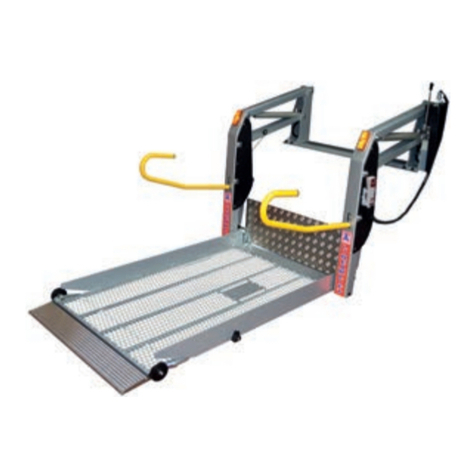
AMF-BRUNS
AMF-BRUNS Linearlift Series User manual
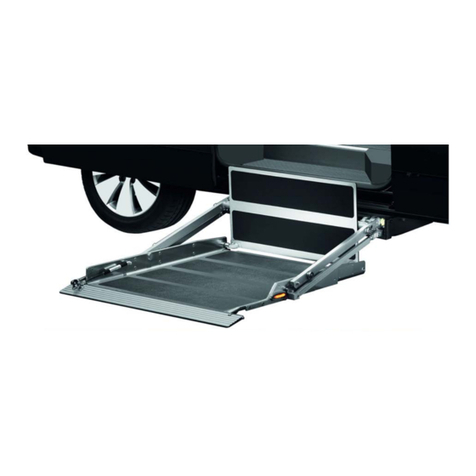
AMF-BRUNS
AMF-BRUNS K70 User manual

AMF-BRUNS
AMF-BRUNS HUBMATIK K90 User manual

AMF-BRUNS
AMF-BRUNS BSL 350 User manual
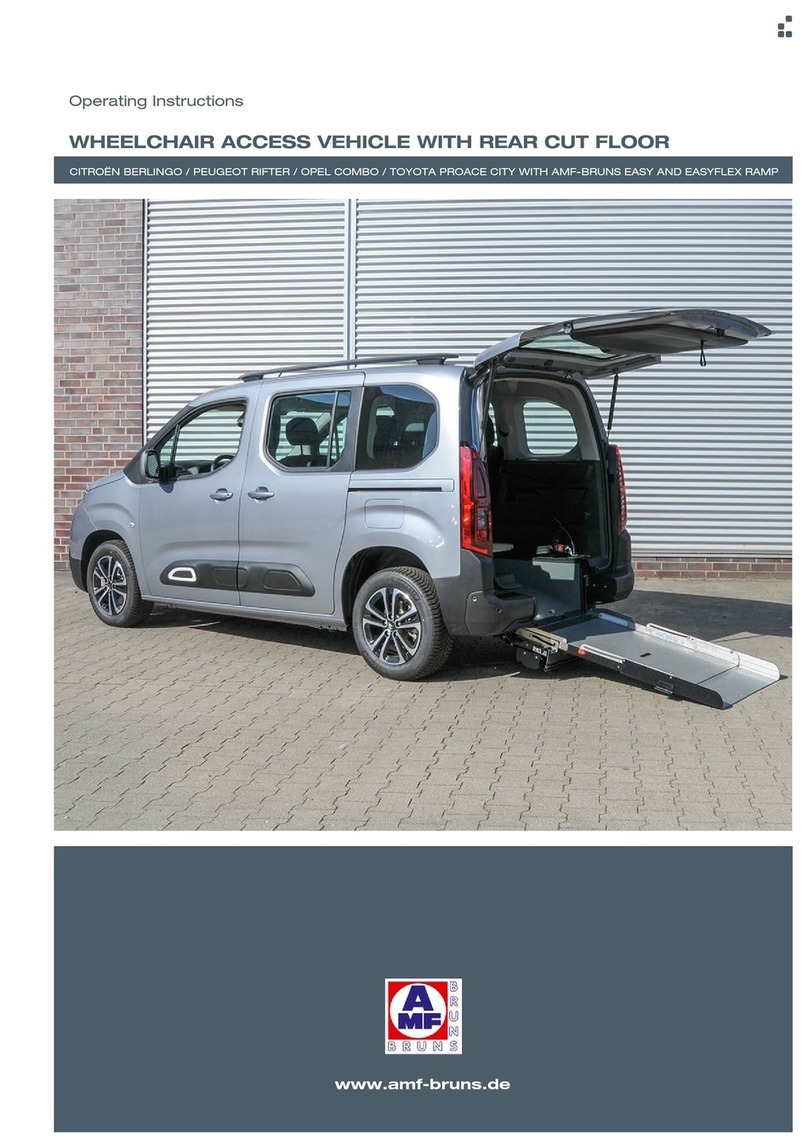
AMF-BRUNS
AMF-BRUNS Easy-Flex-Ramp User manual
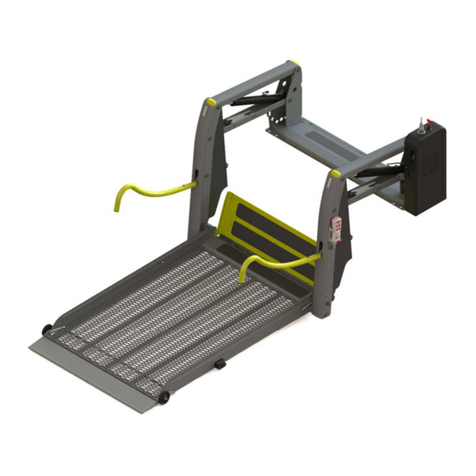
AMF-BRUNS
AMF-BRUNS LINEARLIFT AL1 User manual
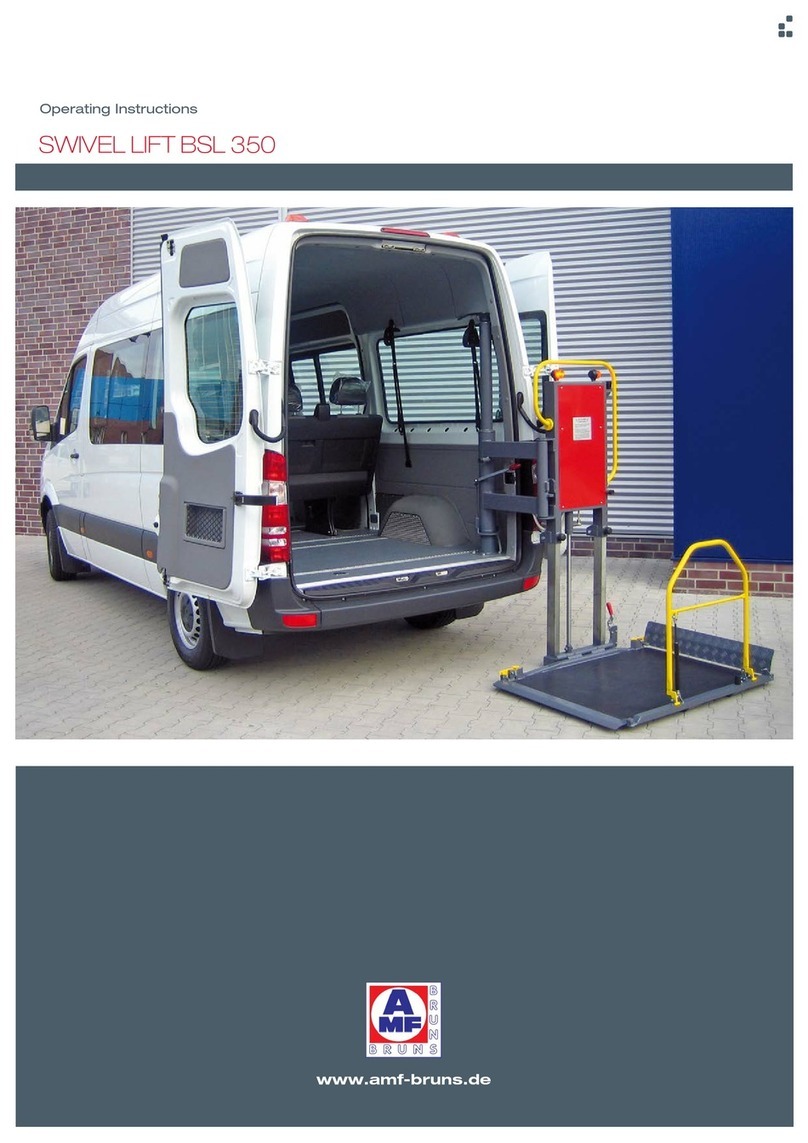
AMF-BRUNS
AMF-BRUNS BSL 350 User manual

AMF-BRUNS
AMF-BRUNS LINEARLIFT AL1 User manual

AMF-BRUNS
AMF-BRUNS BSL 350 User manual
